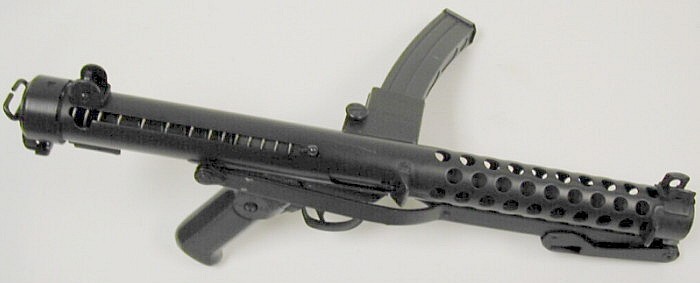Topic: Militaria

New Machine Carbine for Canadian Army
The Sydney Morning Herald, 29 April, 1953
Korea Troops Test New British Gun
New York, April 28 (A.A.P.)—Canadian and other Commonwealth units of the First Commonwealth Division in Korea are testing a new machine-gun.
The gun is the British made Patchett machine-carbine.
According to Canadian war correspondent Bill Boss, it will replace the unpopular Sten gun in the Canadian Army if the tests are successful.
The Patchett is described as the perfect paratrooper's weapon.
It is all metal and weighs 8 ½ lbs. complete with a 10-inch knife-type bayonet, sling and filled magazine.
It can be fired from the shoulder, using sights adjustable for 100 and 200 yards, or from the hip.
A Canadian warrant-officer said: "Its appearance alone gives the soldier confidence which he has not got in his Sten. Of 600 rounds I've fired, there has only been one feed stoppage."
Ottawa Citizen, 15 June, 1953
More Details Released on New Machine-Carbine
By Bill Boss, Canadian Press Staff Writer
With the Canadian in Korea—A few more details about the Patchett machine carbine, recommended for use by Canadians in Korea, have been released by 1st Commonwealth Division headquarters.
The weapon has been thoroughly tested by all battalions in the division as a replacement for the Sten carbine. Brig. Jean Allard, commander of the Canadian Brigade, on the basis of the Canadians' tests, has recommended that it be obtained for use in Korea only.
Test indicated, he said, that the Patchett is superior to the Sten, but still not the answer to the army's search search for an automatic weapon capable of good close-in performance, yet of accuracy at distances up to 200 yards.
It may be reported that the Patchett is a nine-millimeter weapon, the same calibre as the sten.
Its rate of fire is 550 rounds per minute, about the same as the Sten.
It's slightly curved magazines hold 34 rounds. They can be loaded by hand, and their roller-bearing platform feeds the round smoothly, reducing stoppages. Loaders are needed for charging Stan magazines which usually feed improperly, causing stoppages.
WO2 George Maguire of Ottawa, the brigade's senior armorer, who conducted the Canadians' Patchett tests, said: "At 30 yards it cam fire 2 1/2-inch groups, which is as good as a service rifle can do. I've been riddling tin cans regularly with it ay 150 yards. The effective range for most nine-millimeter is 125 yards."
Patchett features which persuade soldiers it is better than the Stan are its appearance, its precision machining, its weight (8 1/2 pounds) and its balance, with ot without its 10 1/2 inch bayonet.
The fact that its butt can be flipped under and locked to the barrel, thereby shortening it and making it suitable for both firing from the hip or close in fighting, is another advantage.
Allard and his staff feel, however, that though for immediate use in Korea it should be bought, it has defects which ought to be corrected before it is adopted for general use in the Canadian Army.
He recommended, indeed, that Canada continue her own research for a suitable automatic weapon.
The Patchett is going to be rechristened too. It is proposed to call it the Sterling machine carbine.

Ottawa Citizen, 20 December, 1956
Patchett Gun Replaces Sten
By The Canadian press
The Sterling sub-machine-gun, formerly known as the Patchett, has been adopted to replace the Sten gun used by the Canadian army since early in the Second World War.
Army headquarters announced today that the government munitions agency, Canadian Arsenals, Ltd., of Long Branch, Ont., will manufacture the new gun with production expected to begin next year.
The Sterling, a nine-millimetre, fully automatic and single shot weapon, is already in use by the British army. Test teams have fired it under all weather conditions, including the coldest temperatures of the sub-Arctic, and found it superior to anything now in use.
The new sub-machine-gun is a compact weapon weighing only six pounds. Because of its simplicity, it can be mastered in a short time and its size makes it ideal for carrying in the cabs of military vehicles.
